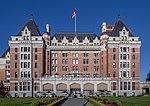Church of Our Lord (Victoria, British Columbia)
Anglican Church in North America church buildingsAnglican church stubsAnglican churches in British ColumbiaBritish Columbia building and structure stubsCanadian church stubs ... and 7 more
Carpenter Gothic church buildings in British ColumbiaChurches in Victoria, British ColumbiaChurches on the National Historic Sites of Canada registerHeritage sites in British ColumbiaNational Historic Sites in British ColumbiaReformed Episcopal church buildingsTourist attractions in Victoria, British Columbia

The Church of Our Lord, built in 1866-1870 and is located at 626 Blanshard Street in Victoria, British Columbia, Canada, is an historic Carpenter Gothic church that is designated as a National Historic Site of Canada. It has been affiliated with the Reformed Episcopal Church since its beginning, which became a member of the Anglican Church in North America, upon its creation in 2009.
Excerpt from the Wikipedia article Church of Our Lord (Victoria, British Columbia) (License: CC BY-SA 3.0, Authors, Images).Church of Our Lord (Victoria, British Columbia)
Blanshard Street, Victoria Downtown
Geographical coordinates (GPS) Address Nearby Places Show on map
Geographical coordinates (GPS)
| Latitude | Longitude |
|---|---|
| N 48.42 ° | E -123.364 ° |
Address
The Church of Our Lord
Blanshard Street
V8V 9V1 Victoria, Downtown
British Columbia, Canada
Open on Google Maps










